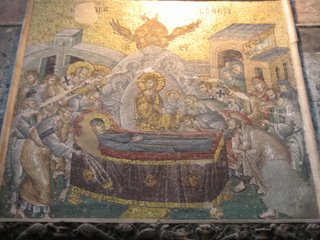
A few days ago, my roommates and I took a day for some adventure around some of the older districts of the city . One of our stops was the Church of St. Savior in Chora ("in the countryside," though it was soon lay within the city walls built by Theodosius c. A.D. 420). The current building dates to the 11th century and is filled with dozens of beautiful, ornate mosaics. A later addition to the church (c. 1320) contains many intriguing frescoes. Two illustrations from the church stood out to me in how they portray Christ.

Anastasis. This fresco depicts the Lord Jesus Christ at the final Resurrection taking Adam and Eve by the hand and drawing them from the grave. I love how Jesus is here the absolute Lord over all things, over the destiny and redemption of humanity. Yet he is not distant; he is personally bringing these two from bondage to decay and into "the freedom of the glory of the children of God" (Romans 8:21). And in the Last Adam giving anew life to the First Adam, we see the truth that redemption in Christ is not a limited phenomenon; rather, he is reconciling the whole world to himself and creating a entirely new humanity (Colossians 1:20). "When this perishable will have put on the imperishable, and this mortality will have put on immortality, then will come about the saying that is written, 'Death is swallowed up in victory' " (1 Corinthians 15:54).

The Dormition of the Virgin. Though probably based more upon tradition than fact or Scripture, this mosaic of the assumption of Mary is an amazing work of art. I'm not exactly sure what all is entailed in the idea of her assumption and being taken into union with her Son and Savior, a few beautiful things are captured here: (1) I think it's a beautiful thing that angels are here at her death, fighting ever still against spiritual powers of evil in service of those who are to inherit salvation (Heb. 1:14). "Precious in the sight of the LORD is the death of His godly ones" (Psalm 116:5).
(2) Jesus is holding an infant representing Mary's soul. I've heard that in Orthodoxy this represents that only upon our death and entrance into the fullness of life in the kingdom are we truly born and come to true life, ever growing in the joyful presence and knowledge of God.
(3) I see the supremacy of Christ in creation here, in that even though he is her Son, he is the one who holds her in his power. Even when Jesus was yet to be born, did he not yet hold Mary's life in his hands? "For by Him all things were created . . . all things have been created through Him and for Him. He is before all things, and in Him all things hold together" (Colossians 1:16-17).
You can see more pictures from our excursion at http://andrewhall.photosite.com. Please e-mail me at drew@aderes.net for a password to see the site.
No comments:
Post a Comment